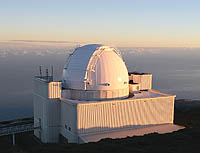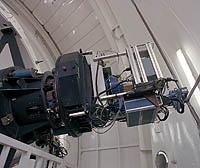Reference:
ING Press Release, XX/XX/2005
Date: Thursday 27 March 2003
Embargo: For immediate release
Other available formats:
PDF | TXT
UK mirror of
this press release
NEW MILKY WAY SATELLITE DWARF GALAXY DISCOVERED
An international team of astronomers report today in a letter published in the Astrophysical Journal the discovery of a new satellite galaxy of the Milky Way. The Ursa Major dwarf galaxy, as it is called, is one of the lowest luminosity galaxies yet known. Its discovery implies there could be many more dwarf galaxies lurking undetected, a fact that could have huge implications for cosmology and dark matter.
A complete census and study of nearby dwarf galaxies is vital to the global understanding of galaxy formation. Some current models predict that large spirals such as the Milky Way should have more satellite dwarf galaxies than are currently known to astronomers. Dwarf galaxies are the most numerous type of galaxy in the universe and are thought to be the first galaxies to form and the building blocks of larger galaxies. Milky Way dwarf galaxies are particularly interesting because they are close enough to be studied in detail.
To improve the completeness of the Milky Way dwarf galaxy population, a team led by Beth Willman (New York University) conducted a search for Milky Way's satellite galaxies using data from the Sloan Digital Sky Survey. The astronomers noticed an excess of red giant stars in a small area in the Ursa Major constellation. Follow-up observations in early March using the Wide Field Camera of the Isaac Newton Telescope confirmed an excess of faint stars in that region, with the stars having the colours and brightnesses expected for a dwarf galaxy 350,000 light-years away. The stars, which contain few elements heavier then hydrogen and helium, could be as old as 13 thousand million years.
The existence or lack of dwarf galaxies fainter than those known also holds promise to substantially improve the understanding of the "missing galaxy problem". Computer simulations that invoke slow-moving particles as dark matter explain why galaxies congregate into giant clusters and filaments. But these so-called Cold Dark Matter models also predict that the Milky Way and other large galaxies should be surrounded by many more dwarf galaxies than astronomers have observed. These "missing galaxies" are not necessarily luminous, however. Theory suggests that most of them could be clouds of dark matter, without any stars to light tme up. By compiling a more complete census of Milky Way's satellite galaxies, Willman's team will enable astronomers to test various dark-matter models that predict how gas in dark-matter-dominated clouds cool enough to form stars.
The Ursa Major dwarf galaxy also gives astronomers a window to the early universe. Finding and studying nearby galaxies with luminosities as low as the Ursa Major dwarf galaxy will help to get at the physics that controls galaxy formation at the extremely low-mass end. Since dwarf galaxies are thought to be the first galaxies to form in the universe, this also will potentially impact on the global understanding of galaxy formation.
The newly discovered galaxy is a dwarf spheroidal galaxy just 1600 light-years wide. It shines with the feeble intensity of only 40,000 Suns, making it the lowest-luminosity and lowest-surface brightness galaxy ever detected, lying just above the detection threshold of the Wide Field Camera. Its tens of thousands of stars appear spread out and practically lost amid Milky Way foreground stars.
The Wide Field Camera is a very powerful instrument for imaging surveys and detection of low-surface-brightness objects. It is mounted at the prime focus of the Isaac Newton Telescope and its field of view covers an area on the sky equivalent to the full moon. Previous discoveries of the Wide Field Camera include the Milky Way's satellite Cepheus dwarf galaxy, a giant stream of stars in the halo of Andromeda galaxy and a giant ring of stars surrounding the main disk of the Milky Way.
This research was published in the following paper: Beth Willman, Julianne J. Dalcanton, David Martínez-Delgado, Andrew A. West, Michael R. Blanton, David W. Hogg, J.C. Barentine, Howard J. Brewington, Michael Harvanek, S.J. Kleinman, Jurek Krzesinski, Dan Long, Eric H. Neilsen, Jr., Atsuko Nitta, Stephanie A. Snedden, 2005, "A New Milky Way Dwarf Galaxy in Ursa Major", Astrophysical Journal Letters, Vol. XXX, pages xxx-xxx.
The Isaac Newton Group of Telescopes (ING) is an establishment of the
Particle Physics and Astronomy Research Council (PPARC) of the United
Kingdom, the Nederlandse Organisatie voor Wetenschappelijk Onderzoek (NWO)
of the Netherlands and the Instituto de Astrofísica de Canarias (IAC)
in Spain. The ING operates the 4.2-metre William Herschel Telescope, the 2.5-metre Isaac Newton Telescope,
and the 1.0-metre Jacobus Kapteyn Telescope. The telescopes are located in the Spanish Roque de Los Muchachos Observatory
on La Palma, Canary Islands which is operated by the Instituto de Astrofísica de Canarias (IAC).
PICTURES
![]()
Caption: INT image of the Ursa Major dawrf galaxy.
Picture credit: .
Available formats: JPEG | TIFF

Caption: Isaac Newton Telescope.
Picture credit: Nik Szymanek.
Available formats: JPEG 1000×765 pixels (138K) | TIFF 2812×2152 pixels at 300 dpi (12.7M)

Caption: Isaac Newton Telescope's Wide Field Camera.
Picture credit: Jens Moser.
Available formats: JPEG 1000×840 pixels (171K) | TIFF 3036×2551 pixels at 300 dpi (25.6M)
FOR FURTHER INFORMATION PLEASE CONTACT:
Dr. Beth Willman
New York University; Center for Cosmology and Particle Physics; Department of Physics; 4 Washington Place; New York, NY 10003; United States
Phone: +1 212 992 8792
Fax: +1 212 995 4016
E-mail: beth.willman@nyu.edu
Dr. David Martínez Delgado
Instituto de Astrofísica de Andalucía; C/. Camino Bajo de Huétor, 50; E-18008 Granada ; Spain
Phone: +34 958 121 311
Fax: +34 958 814 530
E-mail: ddelgado@iaa.es
Mr. Javier Méndez
Public Relations Officer
Isaac Newton Group of Telescopes; C/. Alvarez de Abreu, 68, 2p; E-38700 Santa Cruz de La Palma; Canary Islands; Spain
Phone: +34 922 425 464, +34 616 464 111
Fax: +34 922 425 442
E-mail: jma@ing.iac.es
GLOSSARY
Dark matter. With conventional astronomical methods one can only see the "luminous matter", notably in the form of stars, which reveals its presence by the emission of light. On the other hand, the gravitating mass of various systems such as spiral galaxies or galaxy clusters can be determined from their dynamical properties. After comparing both, a huge discrepancy relative to luminous matter is found, leading to the conclusion that large amounts of "dark matter" must exist.
Although the nature of dark matter remains unknown, it could take two possible forms: baryonic matter or non-baryonic matter. The former is "ordinary" matter, such as makes up the luminous portions of the universe but cast in the guise of objects that are difficult to detect, such as planets, brown dwarfs, and black holes. Non-baryonic matter, on the other hand, would exist as exotic particles, predicted by certain grand unified theories. There are two possible subgroups of exotic dark matter: hot dark matter (HDM) and cold dark matter (CDM). HDM would be composed of particles such as neutrinos, described as hot because they travel at or very close to the speed of light. Neutrinos are a prime candidate, especially in view of recent evidence that has come down in favor of them having mass. CDM would be composed of weakly interacting massive particles (WIMPs). These particles have relatively large masses, travel relatively slowly and interact only weakly with normal baryonic material; hence, they are difficult to detect. Candidates include the axion and the neutralino.
The currently favored view is that CDM makes up the bulk of dark matter in the universe, with perhaps a minor contribution of 10 to 20% from HDM. A key prediction of the CDM model, that large galaxies are accompanied by huge retinues of dwarf galaxies (gravitationally drawn in by the CDM halos), has been winning observational support in the last years. A study of large galaxies that act as gravitational lenses revealed that about 2% of their mass must be in the form of dwarf galaxies -equivalent to thousands of these small systems- to explain the lensing effects.
Dwarf galaxy. A dwarf galaxy is a small galaxy with a very low mass and luminosity. Dwarf galaxies may be elliptical (of which dwarf spheroidal galaxies are a subcategory) or irregular in shape but, in either case, are usually sparsely populated with stars, have low surface brightnesses, low overall luminosities, and consequently are hard to detect. It is usually possible to look straight through a dwarf galaxy. Dwarf ellipticals are populated by old stars and contain little, if any, gas, whereas dwarf irregulars contain younger stars and substantial quantities of gas. Dwarf elliptical galaxies, which typically contain from a few hundred thousand to a few million stars, have diameters of a few thousand light-years and luminosities ranging from about 105 to about 107 solar luminosities, are probably the most abundant species of galaxy in the universe. Dwarf irregulars, which appear to be less abundant than dwarf ellipticals, contain from about 106 to 108 (or, exceptionally, up to about 109) stars.
Satellite galaxy. A small galaxy, typically an irregular or dwarf system, in orbit around a much larger, more massive one. Our own Galaxy, for example, has several satellite galaxies, including the Large and Small Magellanic Clouds.
FOR FURTHER INFORMATION ON THE WEB:
More information on the Isaac Newton Telescope: Public Information on the WHT.
More information on the Isaac Newton Group of Telescopes (ING): Public Information on ING
|



